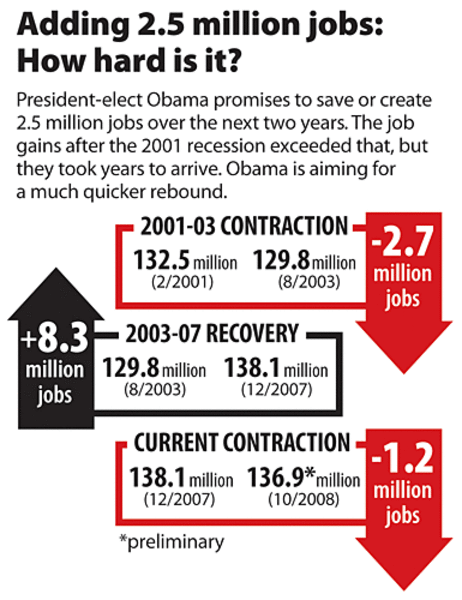Obama's vast jobs plan: How hard?
Loading...
The history of past recessions suggests that President-elect Obama has set a difficult but not impossible target for economic recovery: 2.5 million more jobs within two years.
By announcing this specific goal, alongside a stimulus plan and a team of top economic officials, Mr. Obama signaled that he is focused squarely on the challenge of job losses and an erosion of economic confidence.
He plans to ramp up spending on everything from roads and schools to solar panels and investments in energy efficiency.
The task ahead is formidable.
Before adding jobs at all, the economy must end a pattern of job erosion that has been under way for nearly a year and appears to be accelerating. In the three months ended in October, the economy lost about 651,000 jobs, up from 214,000 for the three months ended in July.
"There is a way out of this," says Lakshman Achuthan, managing director of the Economic Cycle Research Institute, a research group in New York. "It is possible [to add 2.5 million jobs] but it will require that a lot of things go right."
Things going right, in his view, can be summed up in the phrase "V-shaped recovery."
"I don't think anybody remembers what a V-shaped recovery looks like," he says. "They are dramatic. They bring with them a great deal of job gains."
Following the past two recessions, in 1990-91 and 2001, the job market remained stagnant for a long period. In 2002 and 2003, the number of jobs actually kept declining modestly, even while the economy was officially growing again.
Today, several forces raise the prospect that another "jobless recovery" could happen. The ability of the banking system to provide credit is under stress, and households and businesses have lost significant wealth due to real estate and stock market downturns.
Obama, in announcing his economic team Monday and in a radio address Saturday, was careful not to inflate expectations.
"There are no quick or easy fixes to this crisis, which has been many years in the making, and it's likely to get worse before it gets better," he said.
But V-shaped recoveries have happened plenty of times before. To take one prominent example, the number of jobs began to decline in the summer of 1974 with a deep recession already under way. Three years later, the economy had 4.2 million jobs more than it did before the recession-induced decline began.
Similarly, by the time Obama takes office, a decline in jobs will have been under way for a full year. Then, he's giving himself two years to help engineer job-market gains. And he's giving himself some semantic wiggle room.
In Obama's presidential transition website, an introduction to his radio address defines the goal as "to save or create 2.5 million jobs in the next two years."
The new president might be able to claim to have saved many jobs if, for instance, the government reaches an agreement to help the automobile industry restructure and avoid bankruptcy.
Given the "save or create" phrasing, it's not clear that Obama expects to see a net gain of 2.5 million jobs more in the economy in January 2011 compared with his inauguration this coming January.
But in the radio address, he appeared to set that target: "I have already directed my economic team to come up with an economic recovery plan that will mean 2.5 million more jobs by January of 2011."
As of his Monday press conference, Obama's team is rapidly taking shape. It includes:
•Timothy Geithner, now president of the Federal Reserve Bank of New York, as Treasury secretary.
•Lawrence Summers, a Treasury secretary under President Clinton, will head the National Economic Council.
•Christina Romer, a respected economist at the University of California, Berkeley, will chair the White House Council of Economic Advisers.
•Melody Barnes, an Obama campaign adviser, will head the Domestic Policy Council.
"This is not an ideological group," says Ken Goldstein, an economist at the Conference Board, a business-sponsored research group in New York. "They're going to be George Steinbrenners on economic policy. They're going to be quick to use the hook [and change course] if it's not working."
But to hit the 2.5 million job goal, "they have to be smart" and have some good fortune as far as the course of the current business cycle, he says.
"I believe deeply in the resilience and the spirit of this nation," Obama said. But "we do not have a minute to waste."





